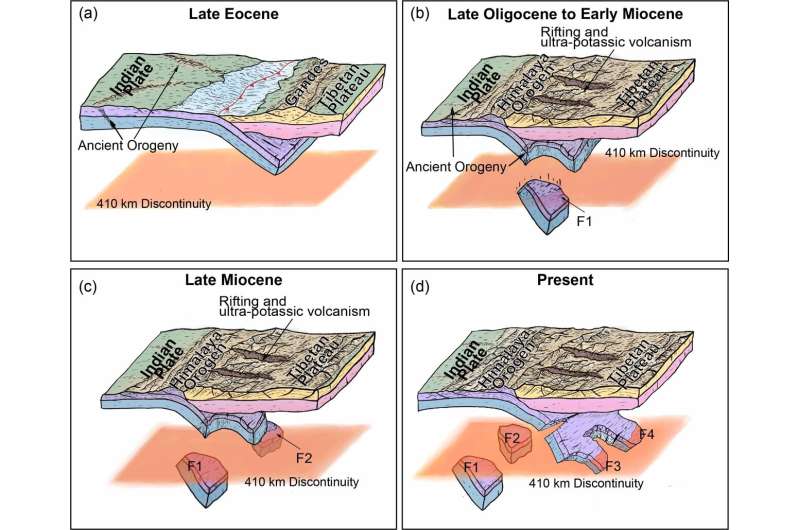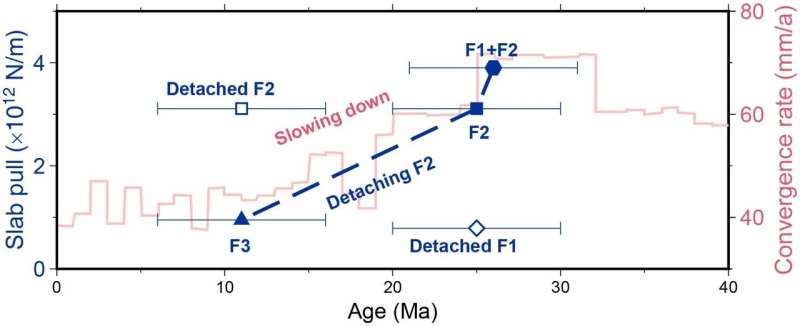This article has been reviewed according to Science X's editorial process and policies. Editors have highlighted the following attributes while ensuring the content's credibility:
fact-checked
trusted source
proofread
New tomographic images shed light on the cessation of Indian continental subduction and ending the Himalayan orogeny

In a recent development in geology published in Science Bulletin, an international research team, including scientists from the Institute of Geology and Geophysics, Chinese Academy of Sciences, the University of Texas at Austin, the University of Missouri, and Guilin University of Technology, has provided crucial insights into the dynamics of the India-Eurasia collision and the Himalayan orogeny.
They achieved this through the recent development of a high-resolution tomographic image of the upper mantle beneath the India-Eurasia collision zone. This new mantle model, enabled by advanced imaging technology, offers unprecedented insights into Earth's geological past and the forces shaping our world.
The research team employed a sophisticated imaging and analysis technique, similar to taking X-rays in the medical field to the Earth, to capture detailed snapshots of the upper mantle beneath the Himalayas and Tibetan plateau. This innovative approach unveiled images of tectonic processes under the India-Eurasia collision zone, shedding light on the dynamics of mountain building and the collision of continental tectonic plates.
The new images reveal seismically fast-velocity anomalies within the mantle transition zone (MTZ) unconnected to the surface. The MTZ is like a boundary layer in Earth's interior, between the upper and lower mantle, extending from 410 km to 660 km in depth.
Dr. Xiaofeng Liang, the lead author, expressed initial surprise, saying, "At the beginning, I couldn't understand why there are so many pieces of these fast-velocity blocks, and they come in different sizes. I showed the results to my officemate, Dr. Yang Chu, a structural geologist, and we engaged in extensive discussions with colleagues from various disciplines."

These anomalies resemble pieces of a puzzle believed to be fragments of the subducting Indian continental lithosphere that broke away. The research team reconstructed the initial northern edge of the Indian continent by reattaching these pieces to the current Indian plate.
After evaluating the composition and temperature of the anomalous mantle in the transition zone, they estimated that the decrease in slab pull force from the broken subducted lithosphere was greater than the ridge push applied to the Indian plate.
One profound implication of these findings is the diminishing slab pull force from the subducting Indian continental lithosphere. Detached lithospheric fragments have reduced this force, decelerating India-Eurasia convergence. The research suggests that as more of the subducted slab breaks off, convergence between the Indian and Eurasian plates will eventually cease. This could lead to the fusion of the two continents, offering a new understanding of supercontinent formation.
The detachment of subducted lithosphere is expected to induce geological changes, including asthenospheric upwelling, plate extension, and surface uplift in the collision zone. These changes have significant geological consequences, explaining the rise of the Himalayas, the initiation of rifts in southern Tibet, and other regional geological phenomena.
This discovery is critical for understanding an enigma that has existed for the past 100 years: what is controlling the continued collision of the two continents of India and Eurasia, and how will it end? It underscores the importance of studying Earth's interior to unravel the complex processes shaping our planet over billions of years. As scientists delve deeper into continental subduction processes, we anticipate further revelations reshaping our understanding of Earth's geological evolution.
More information: Xiaofeng Liang et al, Fragmentation of continental subduction is ending the Himalayan orogeny, Science Bulletin (2023). DOI: 10.1016/j.scib.2023.10.017
Provided by Science China Press




















